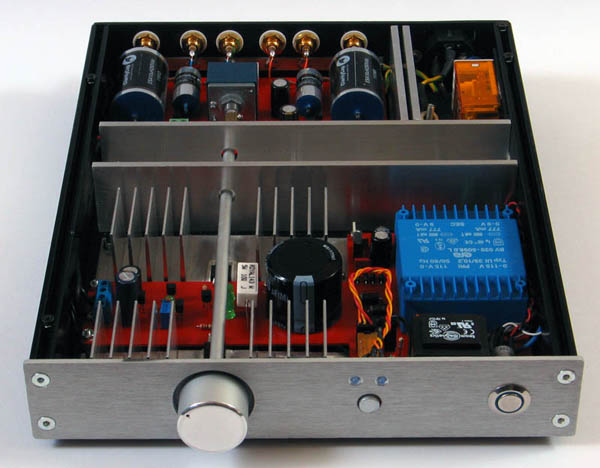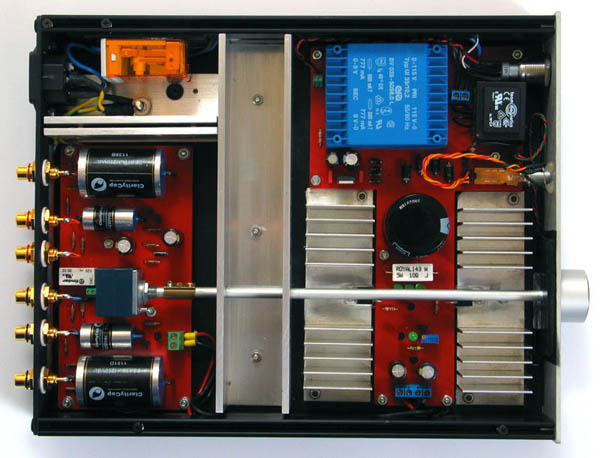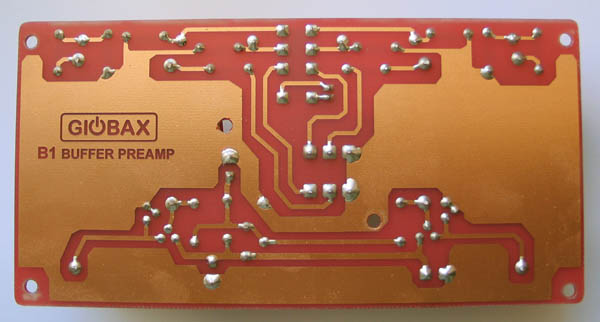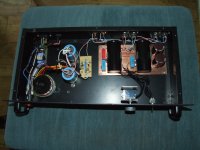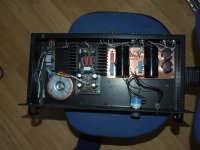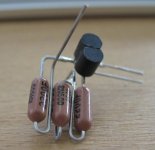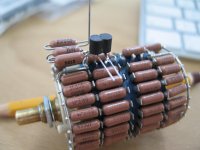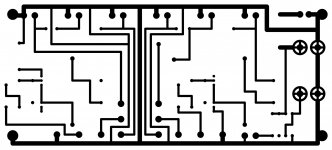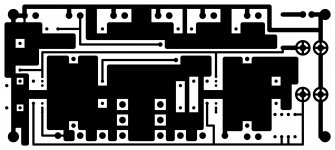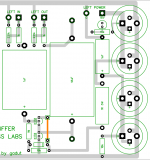My first learning on pcb layout, previously I use schematic menu then convert to pcb. It was so frustating for newbie like me. Then I started to design from pcb menu by placing each component 1by1. I never thought that designing pcb will be so much fun by using 3D rendering from diptrace 
Need your advise on my layout
Need your advise on my layout
An externally hosted image should be here but it was not working when we last tested it.
An externally hosted image should be here but it was not working when we last tested it.
looks great
but might be a bit tedious getting to the jfets, if you should need to do repair or something
appears to me like the jfets would fit nicely into the space at the end of the caps
and according to your copper lines, it would make a natural and shorter connection as well
but might be a bit tedious getting to the jfets, if you should need to do repair or something
appears to me like the jfets would fit nicely into the space at the end of the caps
and according to your copper lines, it would make a natural and shorter connection as well
Nice work. I like the use of the extension rod on the volume pot.
What is the purpose of the alluminium u frame between the PSU and the B1 ? It certainly has no screening properties.
GADUT, I simply downloaded the Gerber files from the PassDIY site and used a FREE Gerber viewer to convert them into .jpg images.
Then it was a simple matter of producing them.
I did cheat though. I only etched the bottom copper layer. The upper layer remained intact. After clearance drilling the necessary holes I made the necessary upper tracks with insulated wire - EASY.
What is the purpose of the alluminium u frame between the PSU and the B1 ? It certainly has no screening properties.
GADUT, I simply downloaded the Gerber files from the PassDIY site and used a FREE Gerber viewer to convert them into .jpg images.
Then it was a simple matter of producing them.
I did cheat though. I only etched the bottom copper layer. The upper layer remained intact. After clearance drilling the necessary holes I made the necessary upper tracks with insulated wire - EASY.
Attachments
Last edited:
What is the purpose of the alluminium u frame between the PSU and the B1 ? It certainly has no screening properties.
Hi. Are you referring to the material or to the form of the frame?
Giovanni
The original B1 PCB
These are converted from the Original Gerber files which are FREE to download.
many guys have modified them to include different caps. My big Obligattos simply connect though holes in the board to the original pads.
I also cut the 0V trace on the bottom of the board (the thick one between the top and the bottom) as this is already made by the 0V ground plane on the other side of the board.
These are converted from the Original Gerber files which are FREE to download.
many guys have modified them to include different caps. My big Obligattos simply connect though holes in the board to the original pads.
I also cut the 0V trace on the bottom of the board (the thick one between the top and the bottom) as this is already made by the 0V ground plane on the other side of the board.
Attachments
Last edited:
The first reason is to have a double thick shield between psu and preamplifier... Perhaps I'm missing something, but I think 8mm works better than 4mm. I admit to not knowing much about the s ferromagnetic materials shielding capabilities....
Second reason: the profile has the same thickness of the sides of the case, so I can put weight on the lid without risk of bending.
Third reason ... I have many yards of that frame

Giovanni

Second reason: the profile has the same thickness of the sides of the case, so I can put weight on the lid without risk of bending.
Third reason ... I have many yards of that frame
Giovanni
It'll certainly give the frame stability and strength.
Alluminium has no shielding properties though. Not that the B1 needs much screening. If you look at my interpretation of the same design above, mine is also COMPLETELY SILENT.
Your attention to the look of your amp is absolutely beautiful to the eye.
Anyone building the B1. If you have HUM issues it is almost certainly down to layout or 0V grounding issues and NOT the B1 itself.
The B1 is so tolerant of PSU that its almost legendary.
I did post two photos of mine with an LM317 PSU and a SALAS Shunt Reg. YES, there are minor differences but NOISE and HUM is NOT one of them.
Alluminium has no shielding properties though. Not that the B1 needs much screening. If you look at my interpretation of the same design above, mine is also COMPLETELY SILENT.
Your attention to the look of your amp is absolutely beautiful to the eye.
Anyone building the B1. If you have HUM issues it is almost certainly down to layout or 0V grounding issues and NOT the B1 itself.
The B1 is so tolerant of PSU that its almost legendary.
I did post two photos of mine with an LM317 PSU and a SALAS Shunt Reg. YES, there are minor differences but NOISE and HUM is NOT one of them.
Alluminium has no shielding properties though.
I did some research on this topic .... but I have not found anything that says that aluminum is not a valid shield for EMI / RFI. Certainly there are better materials (iron, copper) but aluminum is normally used for shield in case e cable.
However, I agree with you that the B1 has no screening problems.
Giovanni
I did some research on this topic .... but I have not found anything that says that aluminum is not a valid shield for EMI / RFI. Certainly there are better materials (iron, copper) but aluminum is normally used for shield in case e cable.
However, I agree with you that the B1 has no screening problems.
Giovanni
As far as I can tell, alluminium fails in the EM shield world because it has no magnetic properties.
It may well stop electrons from flying about but most of our problems are caused by the magnetic fields caused by those free electrons.
Only steel and some of its derivatives can effectively shield our delicate circuitry from those irksome stray magnetic fields.
just completed to make a new half layout, I made it a short as possible for input and output, and try to make it a clean layout symmetry. any advice to enhance it? Since I got no experience yet on "do & don't" on pcb layout. Next I'll try to populate it thru pcb sheet, a new journey on making pcb by using laser printer & home ironing.
thanks to @tinitus advice to make short circuit, since previously I tried to follow papa design
@KatieandDad : I also downloaded those gerber file, I opened it with eagle and it's not as I expected as newbie, design a new one with diptrace is a better choice for me
thanks to @tinitus advice to make short circuit, since previously I tried to follow papa design
@KatieandDad : I also downloaded those gerber file, I opened it with eagle and it's not as I expected as newbie, design a new one with diptrace is a better choice for me
Attachments
Last edited:
The B1 is probably one of the most tolerant designs for PCB layout.
If you compare the DCB1 against the B1 they couldn't be any more different.
I only have the B-1 up and running, but have 3/4 completed Mezmorize and Hypnotize DCB1 projects...what are the differences between them and the standard B-1 in terms of sonics? Or do you mean not sonic differences, but about toleration of power supply? If sonic, please tell. I was under the impression from others I have communicated with that there really wasnt a huge sonic difference. I guess I'll find out in due time, but was wondering about the reference of "couldnt be more different."
Thanks,
Russellc
As far as I can tell, alluminium fails in the EM shield world because it has no magnetic properties.
It may well stop electrons from flying about but most of our problems are caused by the magnetic fields caused by those free electrons.
Only steel and some of its derivatives can effectively shield our delicate circuitry from those irksome stray magnetic fields.
That's not true, every conductor can shield electromangentic fields, if it doesn't the shielding is done wrong.
Just thnk of the copper shield of coax cables or have a look at the wallpapers with shielding properties.
It's another thing with static magnetic fields caused by a magnet. To shield them you need material with magnetic properties (mu-metal e.g.). But the main problem in audio is that you suddenly listen to the radio, even if you don't have a radio...
regards
- Home
- Amplifiers
- Pass Labs
- B1 Buffer Preamp
